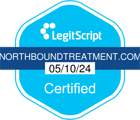Opiate and opioid abuse can have both short- and long-term effects on the body. Some of these impacts are more apparent, while others are much less obvious. If left untreated, opiate and opioid addiction can have extremely damaging and even fatal consequences.
At Northbound Treatment, we’re dedicated to helping those who struggle with opiate addiction get clean, recover from the effects of chronic drug use, and live healthy, sober lives. If you or someone close to you is suffering from addiction, it’s important to have a thorough understanding of the physiological toll it can have on a person. Here’s what you need to know about the effects of opiates on the body and how a drug rehabilitation center can help with recovery.
Opiates vs. Opioids
First off, many people get opiates and opioids confused. Both are narcotic analgesics (powerful pain relievers), and you’ll often hear the terms used interchangeably. However, their definitions are slightly different.
The active ingredient of an opiate is naturally derived from a poppy flower. Some pain-relieving prescription drugs made from poppies include morphine and codeine, as well as the street drug heroin. Conversely, an opioid is a synthetic drug — in other words, the active ingredients are not derived from nature.
Some of the most common opioid drugs include:
- Fentanyl
- Hydrocodone (Vicodin)
- Hydromorphone (Dilaudid)
- Meperidine (Demerol)
- Methadone
- Oxycodone (OxyContin)
- Propoxyphene (Darvon)
The effects of opioids on the body are mostly the same as opiates in terms of pain relief, as well as short- and long-term health impacts. Read on for a breakdown of the effects narcotic analgesics can have on the body.
The Severe Effects of Opiates on the Body
Opiates and opioids are highly potent and exceedingly addictive. Many consider them to be the most dangerous class of drugs in the world today. When opiates are abused, the implications can be just as dire as illegal heroin.
According to the CDC (Centers for Disease Control and Prevention), there were almost 47,000 opioid-related deaths in the U.S. in 2018, which is nearly six times the rate in 1999. Aside from being potentially lethal, signs of opiate use can wreak havoc on virtually every part of a person’s body.
Opiates & the Brain
Since opiates are designed to relieve acute pain, one of the most immediate effects people experience is drowsiness. With ongoing use, many are unable to remain alert during the day, sometimes turning to stimulants to counterbalance their sleepiness.
In the long term, narcotic pain-relievers may lead to depression. Research published in the Journal of the Missouri State Medical Association indicates that opioid use for upwards of 90 days substantially increases a person’s risk for MDD (major depressive disorder).
Opiates & the Liver
Many prescription opioids, such as Vicodin, contain acetaminophen. When acetaminophen is consumed excessively, it can lead to liver damage. These effects can be particularly damaging for those with existing liver disease. Also, when a person drinks alcohol in addition to taking opiates, it makes it especially hard for the liver to process it in conjunction with acetaminophen to avoid toxicity.
Opiates & Digestion
Opiates and opioids bind to the gastrointestinal tract and directly impact the muscles within a person’s digestive system. This slows down digestion and often leads to constipation. When constipation is chronic, as is common with opiate addiction, it can lead to more concerning conditions, such as resultant peritonitis and small bowel obstruction.
Another related side effect of opioid use is nausea, which for many users, leads to vomiting. In some cases, vomiting can occur suddenly or be uncontrollable. This is particularly dangerous for those who fall asleep when taking opiates, as it can cause them to choke.
Severe cases are referred to as opioid-induced bowel dysfunction (OIBD). In addition to constipation and vomiting, OIBD can involve a number of digestive and gastrointestinal issues, including gastro-oesophageal reflux, delayed digestion, bloating, intense abdominal pain, and hard stool. OIBD goes beyond the physical effects of opiates on the body — it can impact a person’s quality of life.
Opiates & the Immune System
Ongoing use of a narcotic painkiller is also associated with a suppressed immune system. Medical research suggests that opioid and opiate abuse reduces the ability of white blood cells to multiply and develop into mature, functioning cells. White blood cells are essentially immunity cells, and they’re vital for defending against viruses, bacteria, and other threats to a person’s health. In other words, an opioid addiction can make you more vulnerable to infections.
Furthermore, a medical review published in the American Journal of Therapeutics explains that chronic opiate use inhibits the body’s humoral response, which is the production of critical bodily fluids needed to protect against disease. This includes antibodies and cytokines, both of which are secreted as a response to infections.
Opiates & the Nervous System
The immunity effects of opioids on the body are directly related to the impacts on the central nervous system. In fact, research indicates that the reason a narcotic painkiller can cause immunosuppression is that within the nervous system, it increases activity in the HPA (hypothalamic-pituitary-adrenal) axis. The HPA axis is essentially the body’s stress response hub. As a result, the sympathetic nervous system can’t effectively create white blood cells.
Also, while it seems counterintuitive, ongoing or excessive use of opioids can cause hyperalgesia (an abnormal increase in pain sensitivity). Narcotics typically block the receptors that send pain signals from the nervous system to the brain. In rare cases, chronic use can cause the body to try to reverse the effects by activating other pain signals. The phenomenon is called opioid-induced hyperalgesia (OIH), and it can make someone hypersensitive to otherwise minor discomforts.
One of the short-term effects of opiates on the body is psychomotor impairment. In essence, this means that reflexes can be substantially slowed down under the influence of narcotics. The most obvious example is a slowed reaction time while driving, but psychomotor impairment can also involve delayed verbal responses, emotional reactions, and physical movements in virtually any scenario.
Long-Term Repercussions of Abusing Opiates & Opioids
When opiates are administered for a short period under the careful supervision of a physician or another medical provider, they can effectively relieve pain without any adverse effects. However, when someone takes opiates for an extended period (with or without a prescription), they might become impacted by many of the long-term effects of opiates outlined above.
Additionally, long-term consumption of narcotics often leads to chemical dependency. This urge to use opioids to feel “normal” can end up having physical, emotional, and legal consequences. Before long, opiate users often require larger doses to achieve the same effect, which is a slippery slope. When a person is chemically dependent on opiates and goes without their regular dose, they’ll begin to experience withdrawal symptoms.
Opiate Detox at Northbound Treatment
When it comes to overcoming opioid/opiate drug addiction, the first step for many people is detoxification. Opioid and opiate withdrawal is a difficult, uncomfortable process, but it’s a necessary component of detoxing from narcotics. That being said, we strongly suggest medically supervised detox. Although many addicts are tempted to detox at home, around-the-clock clinical supervision will ensure safety.
The clinical staff at Northbound Treatment is knowledgeable about the effects on the body and prepared to help clients safely through the detox timeline for opiates onto the next stages of recovery. Not only is our detox program safe, but it’s also comfortable and completely customizable; it’s the best way to detox from opiates. All treatment plans at Northbound are individualized based on the client’s unique needs and circumstances, and if necessary, we can always adjust a program as it progresses.
Northbound’s Approach to Opiate Addiction Treatment
Northbound utilizes a holistic approach to opiate addiction treatment, which ensures that each and every client has access to a full continuum of care. We offer a variety of programs that cater not only to addiction recovery but also to physical, mental, emotional, and spiritual wellbeing.
Dual Diagnosis
Many clients at Northbound Treatment have a dual diagnosis (or co-occurring disorders). This means they struggle with both addiction and mental health issues, such as trauma, anxiety, depression, OCD (obsessive-compulsive disorder), bipolar disorder, borderline personality disorder, or codependency. In many instances, substance abuse is a result of a mental health disorder, while in other cases, mental health issues are caused by excessive drug use.
Start Today
The team at Northbound Treatment is here to support you through every step of your journey to sobriety. From detoxification and stabilization to addiction treatment and aftercare, we’re dedicated to providing you with the tools and guidance you need to get sober and reach your personal goals.
As part of our commitment to effectively guiding clients to sobriety with programs that suit their needs, Northbound offers inpatient rehab, partial hospitalization treatment, outpatient treatment, and even telehealth outpatient services. We also provide transitional support and comprehensive aftercare programs to help ensure each client can effectively adjust to day-to-day life.
Northbound is an in-network provider for most major insurance companies, and we can help you with a payment option that fits your needs. If you or a loved one is struggling with an addiction to opiates or opioids, we encourage you to reach out to Northbound Treatment today. Give us a call at (844) 919-0403 or fill out our online form to get started with admissions.
Sources:
- Benyamin, Ramsin et al. “Opioid Complications and Side Effects.” Pain physician 11.2 Suppl (2008): S105-20. Print., https://www.ncbi.nlm.nih.gov/pubmed/18443635
- Semenkovich, Katherine et al. “Prescription Opioid Analgesics Increase Risk of Major Depression: New Evidence, Plausible Neurobiological Mechanisms and Management to Achieve Depression Prophylaxis.” Missouri medicine 111.2 (2014): 148–154. Print., https://www.ncbi.nlm.nih.gov/pmc/articles/PMC6179498/
- Soleimanpour, Hassan et al. “Opioid Drugs in Patients with Liver Disease: A Systematic Review.” Hepatitis monthly 16.4 (2016): e32636. Print., https://www.ncbi.nlm.nih.gov/pmc/articles/PMC4887963/
- Kurz, Andrea, and Daniel I. Sessler. “Opioid-Induced Bowel Dysfunction: Pathophysiology and Potential New Therapies.” Drugs 63.7 (2003): 649–671. Print., https://www.ncbi.nlm.nih.gov/pubmed/12656645
- Roy, S., and H. H. Loh. “Effects of Opioids on the Immune System.” Neurochemical research 21.11 (1996): 1375–1386. Print., https://www.ncbi.nlm.nih.gov/pubmed/8947928
- Hall, D. M., J. L. Suo, and R. J. Weber. “Opioid Mediated Effects on the Immune System: Sympathetic Nervous System Involvement.” Journal of neuroimmunology 83.1–2 (1998): 29–35. Print., https://www.ncbi.nlm.nih.gov/pubmed/9610670
Author
-

President, CEO & Founder at Northbound Treatment Network
Paul Alexander is the CEO, President & Founder of Northbound Treatment Network in Newport Beach, California. He believes wholeheartedly in transformational leadership, organizational health and effective, fully integrated substance use disorder and mental health treatment. With over 27 years of experience in behavioral healthcare, Paul has extensive knowledge of “in vivo” treatment modalities, clinical development, operations, strategy, marketing and financial planning. He has been widely recognized for his development of collegiate-based residential treatment programs for students in recovery and authored a research study at The University of California confirming this modality’s effectiveness.
Paul’s comprehensive professional experience, willingness to innovate, and emphasis on organizational health are vital factors in Northbound’s continued success. Paul received his Certified Addiction Treatment Specialist training at Saddleback College in Mission Viejo, CA, and was awarded Outstanding Alumni Service Award in 2002. Paul holds a Bachelor of Arts degree in Criminology, Law and Society, Summa Cum Laude, from University of California, Irvine, and a Juris Doctorate degree from Loyola Law School of Los Angeles. Paul currently serves on The National Association of Addiction Treatment Providers (NAATP) board. In addition, he serves on The Family Recovery Foundation board and The CarePossible board in Orange County; both organizations are committed to raising funds for family recovery and treatment for former military personnel. Paul is in recovery himself and lives in Orange County with his wife Silvana and his two young sons, Noah and Dean.










